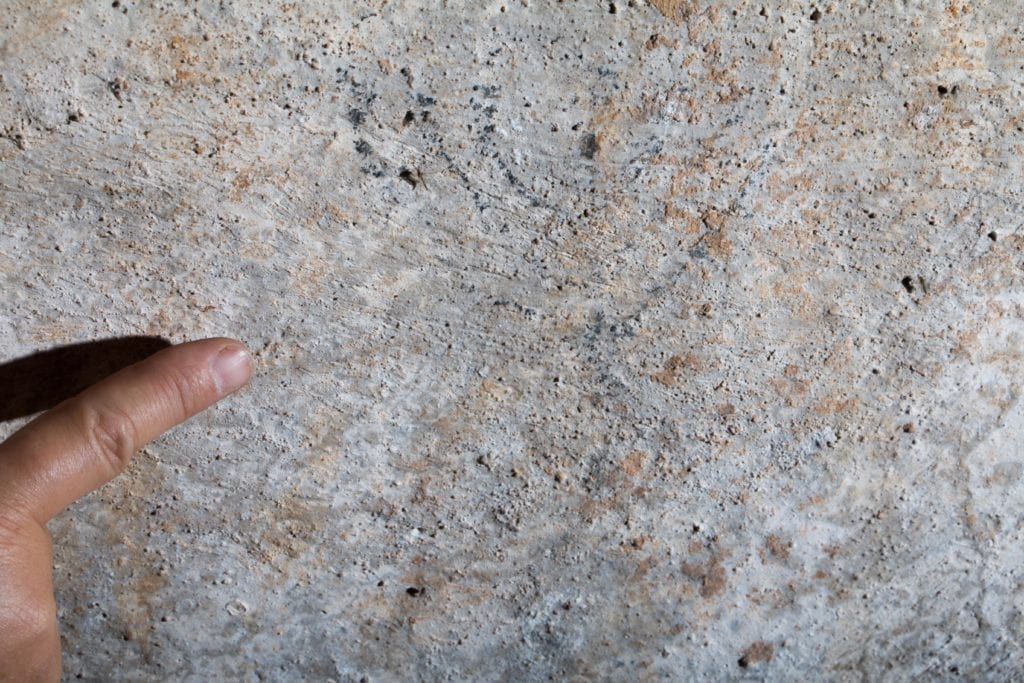A graffito drawing of a seven-branched menora (candelabrum) was discovered almost four decades ago at the entrance to a tomb on the outskirts of the Arab village of Mikhmas northeast of Jerusalem in a survey initiated by the Staff Office for Archaeology in Judea and Samaria of the Civil Administration. The unit is responsible for historical sites in Judea and Samaria, pursuant to the Antiquities Law. But no one paid attention to the finding.
The shortcode is missing a valid Donation Form ID attribute.
Now, the important archaeological finding has been brought to light by Dr. Dvir Raviv of Department of Land of Israel Studies and Archaeology at Bar-Ilan University in Ramat Ran (near Tel Aviv). He has just published an article about the graffito in the archaeology and history journal In the Highlan’s Depth, which appears twice a year.
The menora engraving found in Mukhmas dates back to the period between the Hasmonean era and the Bar-Kochba revolt in the second century CE considered a rare and unique find as decorative use of the Temple menorah was rare during this period. The most prominent examples found to date include depictions of the menora on coins of the Hasmonean ruler Mattathias Antigonus, on objects and remnants from Jerusalem, on a stone table in Magdala north of Tiberias, and on the Arch of Titus in Rome.

Mikhmas is the same village as the biblical Michmas, where ceramics from the Byzantine era have been found. Remains of old masonry, apparently a church, were previously found there.
The use of a menora to decorate the façades of Jewish tombs was quite common in ancient times, but this is only the second time that a menora has been discovered on a Jewish tomb from the period preceding the Bar-Kochba revolt. A long-known example is Jason’s Tomb in Jerusalem, which dates back to the Hasmonean period. It has small, schematic carvings on the walls of the entrance vestibule, unlike the large, decorated menorah discovered on the façade of the Mukhmas tomb.
The menorah engraving in the village of Mukhmas resembles paintings of two seven-branched candelabra documented in the al-‘Aliliyat caves, a group of caves nearby that served as a hiding place and refuge during the Second Temple period and the days of the Jewish revolts against Rome.
Due to the rare use of the menora as an artistic decoration from the Second Temple period until the Bar-Kochba revolt and based on the contexts in which the candelabra of this period were discovered, it has been suggested that the menorah may have been a motif related to the Temple and the priesthood that served in it during this time.
The depictions of candelabra found on the outskirts of Mukhmas and the mention of Mikhmas (currently the village of Mukhmas) in the Mishna as the place from which selected semolina wheat was brought to the Temple may indicate that a priestly population lived there during the Second Temple period. In addition, Mikhmas is mentioned as the dwelling place of Jonathan the Hasmonean, where he began to establish his status in Judea after the death of his brother Judah Maccabee.
“Jonathan’s choice of the town as the base from which to consolidate his control of Judea may have been linked to the location of Mikhmas in a densely-populated area of Jews who supported the Hasmoneans during the years of the revolt,” said Raviv. “Due to the difficulty in determining the exact date of the menora’s graffito and the scarcity of explicit references to priests in Mikhmas during the Second Temple period, it is possible that a group reached the site only after the destruction of the Temple and lived there during the period between the revolts,” he concluded.
As part of a Benjamin survey conducted in the 1980s, ancient remains that belonged to a large settlement that existed there for many periods
were documented in the heart of the village of Mikhmas and its surroundings, Raviv wrote. The grafitto was hewn in the wall of a large cave with a round outline about seven meters in diameter and four meters high. No details were given about how to access the bottom of the large cave. It is possible that the space was originally used as a cistern.
The lamp was engraved at the center of the entrance, about seven centimeters below its ceiling and centimeters above the opening of a room. The width of the lamp is about 40 cm. and the height is about 30 cm. The lamp has seven branches, with six coming out of a central arm.
“The general shape of this seven-branched lamp is reminiscent of the Temple lamp,” he added.
The caves served, among other things, as a hiding place and refuge in the days of the Second Temple and in the days of the revolts in the Romans…The appearance of seven-branched lamps dating from the end of the Second Temple period to the days of the Bar Kochba Revolt as a decoration was unusual in the area.”
The shortcode is missing a valid Donation Form ID attribute.



